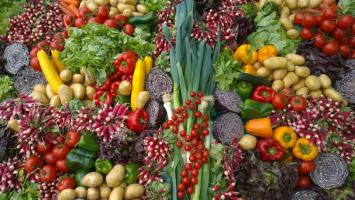
DIET & LIFESTYLE
DISCOVER HOW TO HEAL
Written by John Immel, Food is an important way to build relationships, and studies show that having friends and socializing is good for your health too. Ayurveda does not ask you to avoid these precious moments! Ultimately, there are many legitimate reasons people go out to eat, including business meals, travel, romance, celebrating, reconnecting with a friend, and even to save time cooking and cleaning. Then, there are days where you are too tired and don't feel like cooking. These easy-to-implement guidelines will give you lots of tips and ideas to make these celebrations healthier when dining out. You don't have to follow them all - just start with the ones that seem easiest to you. First, let's acknowledge it's hard to stay healthy eating out at restaurants. Restaurant food is luxury food, designed to entice and seduce rather than support your long term health goals. Restaurants have to make sure the taste of the food is compelling to get you to return. They try to tempt you, despite your best intentions to resist overindulgence. Furthermore, most people want rich and decadent foods when eating out. Restaurants know this - you don't go out to eat for austerity. Menus, therefore, cater to this wish. There's often a light (and boring) dish on the menu, but who can resist the alluring extravagance of fettuccine or lobster bisque? At restaurants, food must appeal to a broad diversity of individuals and often will not support your unique constitution. The restaurant industry is very competitive and has huge overhead, so food needs to taste good in the most cost effective way possible. This means that ingredients are not always top shelf. Cheap oils, non-organic and GMO produce, and artificial ingredients are common in restaurant food. Cooking methods and food storage may include use of plastic. So, while it may sound like a treat to go out, the next day you might regret your decision for a number of reasons. Gas, bloating, heartburn, and weight gain are the most common side effects. Your symptoms can disrupt your sleep. When eating out frequently, you may notice that your pants feel tighter and your head feels sleepier. You might feel puffy from the excessive use of salt. Burning or diarrhea due to spicy food, constipation, or headache the morning after are some other unfavorable outcomes. If you have these symptoms, find a digestive herbal remedy here. That being said, sometimes eating out at restaurants is healing. Vata individuals often need the rich saltiness that eating out provides. These individuals may become constipated, deficient, or dry by eating home cooked foods if they are not rich enough. Restaurant foods are especially supportive for clients with eating disorders like anorexia who have trouble adding enough salt, fat, and calories to their meals. If you feel better and your health improves when eating at restaurants, it means you are probably too austere with your diet. Preparation for Eating OutSome simple tips will help you both enjoy the experience and feel good. Preparation for the big celebration, mindfulness during the event, and follow-up after the fact all create opportunities to both prevent imbalance and ensure a quick recovery.Step 1: Schedule your meal at lunch, or at least earlier in the evening. Your body is stronger earlier in the day to digest the food, process toxins, and burn off calories. Step 2: Check out menus online in advance. Are there healthy options on the menu that appeal to you? Does it fit your budget? Japanese, Thai, and Vietnamese soups digest very easily and are generally lighter. Look for popular new farm-to-table restaurants which are more likely to have seasonal, local food. Mediterranean and Middle Eastern cuisines usually digest well because of fresh herbs, but avoid lentils if they are too gassy for you. Italian and Indian restaurants often serve foods that are too rich or heavy for most people on a regular basis. Step 3: Eat lightly and simply in the meals both before and after. It may help to eat a small but healthy snack before dining out to avoid starvation binging, especially for late night social gatherings. At the RestaurantStep 1: Choose a responsible amount of food. No food is ever off-limits, and as long as it is eaten in an appropriate quantity and with the proper precautions, it should be fine. Only you can discover the appropriate amount for your body, and you can only do so by listening. If you've eaten too much, you'll know - there will be a sense of heaviness, tiredness, and stagnation in the body and stomach. Notice the amount you ate and remember to scale back in the future. Step 2: Chew it well. Whenever you are in the worst of food situations, chew your food carefully. Saliva has digestive enzymes. Try to ''digest'' the food as much as possible in your mouth. Unchewed food is even more difficult to digest. Plus, the slower you eat, the less you'll eat of potentially harmful foods, without feeling too restricted. Step 3: Always order a salad or vegetable sides. If your main meal is lacking them or needs more fiber, order vegetable sides or incorporate a salad.The roughage of the salad helps elimination. The bitter taste of the salad increases bile production and flushes the gall bladder, helping you digest heavy fats. Order your salad with a vinaigrette dressing instead of ranch. The sour taste of vinegar also aids in fat metabolism by stimulating bile production. Step 4: Order hot water with lemon. Hot water is a great way to get your digestive fire going and the sour taste of lemon improves digestion. Sip throughout the meal. Do not drink ice water or cool drinks - they will extinguish your digestive fire and thwart all your efforts. Step 5: Avoid perfectionism. As with all of Ayurveda, don't get bogged down by too many details. Even though we've given you lots of tips, don't obsess over them. You won't be able to find the perfect Ayurvedic option on most menus. Be reasonable and just do what you can. Here are some more general guidelines:
Follow-Up: Recovery after the MealStep 1: Enjoy a stroll after your meal. Taking a short walk around the block after your meal revs your metabolism, adds an element of mobility, and breaks up heaviness from overeating. Step 2: Consider Triphala before bed. Triphala is a mild, non-habit-forming laxative that is good to take the evening after indulgence, right before you go to bed. It will give your body a gentle cleanse, will help remove any lingering toxicity formed by the food, and will reset digestion so you feel ready to go the next day. Step 3: Give Thanks, Release Regret, and Have Fun. If you eat anything with guilt or regret, it will certainly harm your body more than if you eat it with an attitude of thanks and joy. Eating a piece of pizza or a slice of cake is not the end of the world, and it's important to keep that in mind. Focus on being thankful and enjoying the quality of time you have with loved ones and don't worry about the food. Tips for Specific Situations and MealsBreakfastAn American breakfast is more over the top than over easy. It is rich, fatty, and sweet, far too often resembling a dessert than a meal. Just think about pancakes, waffles, french toast, cinnamon rolls, and pastries. These dessert-like foods are often served with a side of sausage, bacon, or even steak! This style of breakfast was crafted for those with physically demanding jobs. But, if you have a desk job, a heavy breakfast will undermine performance and make you feel tired and lousy. These meals will make you want to crawl back into bed, despite numerous cups of coffee.Eggs, cheese, and bread are each difficult to digest on their own and are common food allergens for many. Mix them together and top it off with a digestive irritant like coffee, and there are bound to be some undesirable consequences. Choose two out three of these ingredients instead. Some people do better with eggs and sausage, while another person may do well choosing eggs with more carb-based options, like toast and butter. Oatmeal, grapefruit, and granola are lighter alternatives offered by most restaurants. Ask for whole wheat toast, and if you don't want a lot of butter, ask for it dry. Omelettes are a great way to work in vegetables. Minimize syrups and jams, which are too sugary and usually contain corn syrup. Be careful with pancake mixes, biscuits, and other pastries, as they often contain hydrogenated oils. CheeseburgerA cheeseburger with french fries is sure to weigh you down, combining the heaviness of red meat, dairy, and wheat. French fries pair deep fried food with high glycemic potatoes. This meal is nearly void of green vegetables, save a chance piece of lettuce. In this situation, we suggest substituting the fries for a salad or eating the burger without the bun. Some people even wrap the burger in lettuce, which acts as a kind of bun and adds an exciting crunch. Green veggies are bitter, and the bitter taste encourages the release of bile which helps your body digest fat.PizzaPizza is another trio of difficult to digest foods, including wheat, cheese, and tomatoes. Everybody loves how it tastes. How many actually feel good and energized after eating it? When we're in social pizza situations, we always order a salad and follow these rules for eating pizza and living to tell the tale.Your ConstitutionEat for your body type. Vatas should avoid raw food and beans. Pittas should avoid fried, oily foods. You can always ask for some butter or olive oil on the side to fatten your dish up. Kaphas should avoid wheat, dairy, and sugar.Restaurant by Restaurant Advice
Most important of all, read through the menu, celebrate, and enjoy what your body is truly craving in the moment. Ask for anything you're suspicious of on the side. Whatever you end up choosing, enjoy your food as you eat it (whether it was the best choice or not)! Savor each bite and be sure to chew it well. READ MORE ON THIS TOPIC
BROWSE SIMILAR ARTICLES BY TOPIC

About the Author John Immel, the founder of Joyful Belly, teaches people how to have a healthy diet and lifestyle with Ayurveda biocharacteristics. His approach to Ayurveda is clinical, yet exudes an ease which many find enjoyable and insightful. John also directs Joyful Belly's School of Ayurveda, offering professional clinical training in Ayurveda for over 15 years.John's interest in Ayurveda and specialization in digestive tract pathology was inspired by a complex digestive disorder acquired from years of international travel, as well as public service work in South Asia. John's commitment to the detailed study of digestive disorders reflects his zeal to get down to the roots of the problem. His hope and belief in the capacity of each & every client to improve their quality of life is nothing short of a personal passion. John's creativity in the kitchen and delight in cooking for others comes from his family oriented upbringing. In addition to his certification in Ayurveda, John holds a bachelor's degree in mathematics from Harvard University. John enjoys sharing Ayurveda within the context of his Catholic roots, and finds Ayurveda gives him an opportunity to participate in the healing mission of the Church. Jesus expressed God's love by feeding and healing the sick. That kindness is the fundamental ministry of Ayurveda as well. Outside of work, John enjoys spending time with his wife and 7 kids, and pursuing his love of theology, philosophy, and language. STUDY AYURVEDA
Questions, Comments & Impressions of 'how to eat at restaurants ayurvedically'?Is there something else you'd like to know about 'how to eat at restaurants ayurvedically'?76 likes      Sign in to review this article Sign in to review this article
|
Join Joyful Belly.
Want our top Ayurvedic recipes and health tips?Subscribe to our free newsletter!

 SAVE ARTICLE
SAVE ARTICLE

 On MeWe
On MeWe On Pinterest
On Pinterest On Facebook
On Facebook On Twitter
On Twitter On WhatsApp
On WhatsApp On Email
On Email


